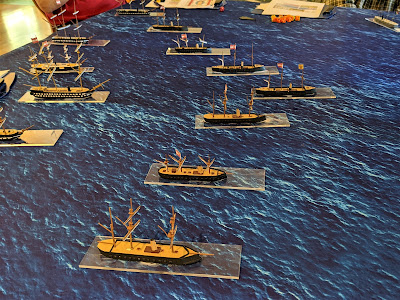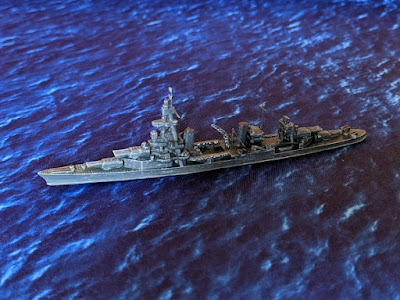After a bit of a hiatus from gaming and painting, a few of us got together on Saturday for an International Naval Wargaming Day game. For those of you that are unfamiliar with International Naval Wargaming Day (INWaD), in 2017 David Manley, well know rule writer and naval gamer, kicked off the first INWaD as a day to "Celebrate the birth of the father of naval wargaming, Fred T. Jane, by running or taking part in a game of your own!"
Our INWaD game this year covered the 1866 Battle of Lissa. We used 1/600 scale ships and the Sail and Steam Navies rules with the optional gun group rule (slightly modified). The ships are from Bay Area Yards, which can still be found on Facebook. It was a group project with 3 of us putting together the ships. We included all 1 Italian ironclads, 7 Austrian ironclads, and 7 Austrian wooden ships that formed the Austrian second line.
The Austrians were set up in 2 wedge formations, with the ironclads leading the way, and could start at full speed. The Italian ships were set up in a line ahead formation, but a little strung out and limited in their initial speed. This was done to represent Italian command confusion in the historic battle.
 |
| Austrian setup, with the ironclads in front |
 |
Italians in line ahead (the last 3 ships are out of the photo)
|
To help get the game going, the Austrians were set up close enough for some ships to make ram attacks on by the end of turn 1.
 |
Austrians closing with the Italian line
|
The Italians fired at the closing Austrians. Most shots were ineffective, but one lucky hit damaged the engines on the Austrian ironclad Salamander leaving it to limp along. But even with the close setup, the Austrians were only able to ram 2 Italians on the first turn.
 |
Two Italians (top and center) are rammed. The lower ship didn't quite make it
|
The ram results proved to be devastating, leaving both Italian ships (Ancona and Re D'Italia) in a sinking condition. The Austrian rammers were able to back out and look for other Italians.
 |
Hapsburg (top) and Erzherzog Ferdinand Max leave Ancona and Re D'Italia sinking
|
The Italians exacted some revenge on the next turn as San Martino rammed and sank Don Juan De Austria.
 |
| Don Juan sinking |
At the rear of the Italian formation, Prinz Eugen rammed Re Di Portogallo but didn't do enough damage to sink the giant ironclad. However, the ships did become fouled and would spend the next couple of turns trying to separate themselves.
 |
Prinz Eugen and Re Di Portogallo locked together
|
By this time the Austrian second line was getting into action. The Austrian wooden 92-gun steam ship of the line Kaiser tried to ram the Palestro, but it was only a glancing blow with no damage done. But this did allow Kaiser to turn parallel to Palestro and unleash a full broadside on the next turn. The short range broadside racked the armor on Palestro and encouraged the Austrians to try to get Kaiser within short range of other Austrian ships.
 |
Kaiser attempts to ram
|
 |
| Kaiser and Palestro exchange fire |
The lead Italian ships, Principe De Carignano and Castelfidardo, found themselves in a target rich environment, which made maneuvering, ramming, and avoiding being rammed difficult.
 |
Lead Italian ships moving through the Austrians
|
During the game, there were some effective gun shots, but most of the time it was just chipping away at armor. Several players remarked that the game felt more like galley warfare than ironclads.
The scrum on the right side was starting to break up with several ships seeking open water, so we decided to call the game at this point. The Italians had lost 2 ironclads, but most of the remaining ships were battered enough that they may no survive further action. The Austrians lost 2 ironclads and 2 wooden ships, but most of their other ships were in decent shape. We decided this was an Austrian Pyrrhic victory - a win but not a great win.
 |
| One last photo of the scrum on the right side of the table |
Overall it was a fun game and kept everyone involved. The results were mostly historical, with ram attacks proving effective and gunnery not so much.


























